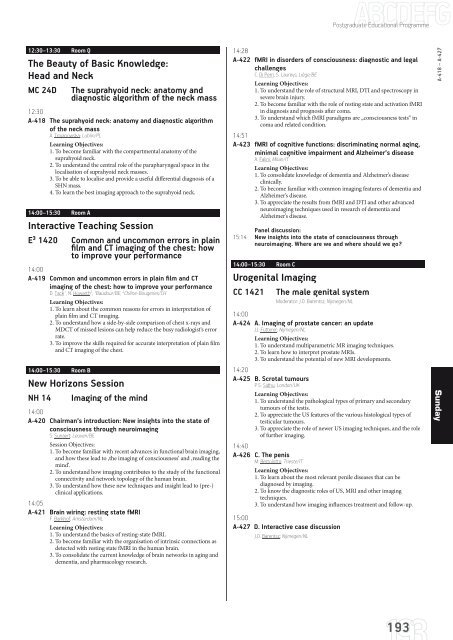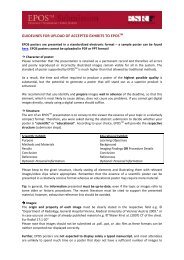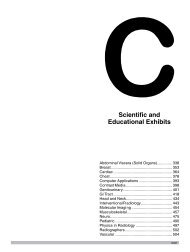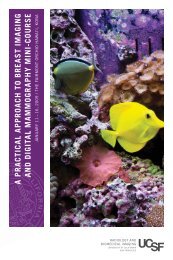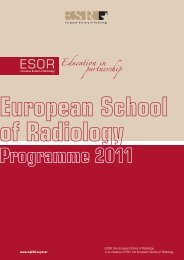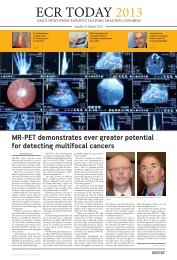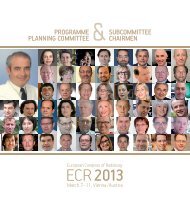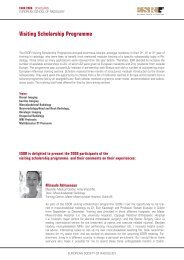ECR 2013 â Final Programme - myESR.org
ECR 2013 â Final Programme - myESR.org
ECR 2013 â Final Programme - myESR.org
- No tags were found...
Create successful ePaper yourself
Turn your PDF publications into a flip-book with our unique Google optimized e-Paper software.
Postgraduate Educational <strong>Programme</strong>12:30–13:30 Room QThe Beauty of Basic Knowledge:Head and NeckMC 24D The suprahyoid neck: anatomy anddiagnostic algorithm of the neck mass12:30A-418 The suprahyoid neck: anatomy and diagnostic algorithmof the neck massA. Trojanowska; Lublin/PLLearning Objectives:1. To become familiar with the compartmental anatomy of thesuprahyoid neck.2. To understand the central role of the parapharyngeal space in thelocalisation of suprahyoid neck masses.3. To be able to localise and provide a useful differential diagnosis of aSHN mass.4. To learn the best imaging approach to the suprahyoid neck.14:00–15:30 Room AInteractive Teaching SessionE³ 1420 Common and uncommon errors in plainfilm and CT imaging of the chest: howto improve your performance14:00A-419 Common and uncommon errors in plain film and CTimaging of the chest: how to improve your performanceD. Tack 1 , N. Howarth 2 ; 1 Baudour/BE, 2 Chêne-Bougeries/CHLearning Objectives:1. To learn about the common reasons for errors in interpretation ofplain film and CT imaging.2. To understand how a side-by-side comparison of chest x-rays andMDCT of missed lesions can help reduce the busy radiologist‘s errorrate.3. To improve the skills required for accurate interpretation of plain filmand CT imaging of the chest.14:00–15:30 Room BNew Horizons SessionNH 14 Imaging of the mind14:00A-420 Chairman‘s introduction: New insights into the state ofconsciousness through neuroimagingS. Sunaert; Leuven/BESession Objectives:1. To become familiar with recent advances in functional brain imaging,and how these lead to ‚the imaging of consciousness‘ and ‚reading themind‘.2. To understand how imaging contributes to the study of the functionalconnectivity and network topology of the human brain.3. To understand how these new techniques and insight lead to (pre-)clinical applications.14:05A-421 Brain wiring: resting state fMRIF. Barkhof; Amsterdam/NLLearning Objectives:1. To understand the basics of resting-state fMRI.2. To become familiar with the <strong>org</strong>anisation of intrinsic connections asdetected with resting state fMRI in the human brain.3. To consolidate the current knowledge of brain networks in aging anddementia, and pharmacology research.14:28A-422 fMRI in disorders of consciousness: diagnostic and legalchallengesC. Di Perri, S. Laureys; Liège/BELearning Objectives:1. To understand the role of structural MRI, DTI and spectroscopy insevere brain injury.2. To become familiar with the role of resting state and activation fMRIin diagnosis and prognosis after coma.3. To understand which fMRI paradigms are „consciousness tests“ incoma and related condition.14:51A-423 fMRI of cognitive functions: discriminating normal aging,minimal cognitive impairment and Alzheimer‘s diseaseA. Falini; Milan/ITLearning Objectives:1. To consolidate knowledge of dementia and Alzheimer’s diseaseclinically.2. To become familiar with common imaging features of dementia andAlzheimer’s disease.3. To appreciate the results from fMRI and DTI and other advancedneuroimaging techniques used in research of dementia andAlzheimer’s disease.Panel discussion:15:14 New insights into the state of consciousness throughneuroimaging. Where are we and where should we go?14:00–15:30 Room CUrogenital ImagingCC 1421 The male genital systemModerator: J.O. Barentsz; Nijmegen/NL14:00A-424 A. Imaging of prostate cancer: an updateJ.J. Fütterer; Nijmegen/NLLearning Objectives:1. To understand multiparametric MR imaging techniques.2. To learn how to interpret prostate MRIs.3. To understand the potential of new MRI developments.14:20A-425 B. Scrotal tumoursP.S. Sidhu; London/UKLearning Objectives:1. To understand the pathological types of primary and secondarytumours of the testis.2. To appreciate the US features of the various histological types oftesticular tumours.3. To appreciate the role of newer US imaging techniques, and the roleof further imaging.14:40A-426 C. The penisM. Bertolotto; Trieste/ITLearning Objectives:1. To learn about the most relevant penile diseases that can bediagnosed by imaging.2. To know the diagnostic roles of US, MRI and other imagingtechniques.3. To understand how imaging influences treatment and follow-up.15:00A-427 D. Interactive case discussionJ.O. Barentsz; Nijmegen/NLA-418 – A-427Sunday193


